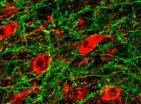(Press-News.org) CHAPEL HILL, N.C. – What characterizes many people with depression, schizophrenia and some other mental illnesses is anhedonia: an inability to gain pleasure from normally pleasurable experiences.
Exactly why this happens is unclear. But new research led by neuroscientists at the University of North Carolina at Chapel Hill School of Medicine may have literally shined a light on the answer, one that could lead to the discovery of new mental health therapies. A report of the study appears March 22 in the journal Neuron.
The study used a combination of genetic engineering and laser technology to manipulate the wiring of a specific population of brain cells deep in a portion of a midbrain area that's known to promote behavioral responses to reward.
"For many years it's been known that dopamine neurons in the ventral midbrain, the ventral tegmental area, or VTA, are involved in reward processing and motivation. For example, they're activated during exposure to drugs of abuse and to naturally rewarding experiences," said study lead author Garret D. Stuber, PhD, assistant professor in the departments of Psychiatry and Cell and Molecular Physiology, and the UNC Neuroscience Center.
"The major focus in our lab is to determine what other sorts of neural circuits or genetically defined neural populations might be modulating the activity of those neurons, whether it's increasing or decreasing their activity," Stuber said. "In our study we found that activation of the nearby VTA GABAergic neurons directly inhibit the function of dopamine neurons, which is something that's never been shown before."
In the past, researchers have tried to get a glimpse into the inner workings of the brain using electrical stimulation or drugs, but those techniques couldn't quickly and specifically change only one type of cell or one type of connection. But optogenetics, a technique that emerged about six years ago, can.
In this study, the scientists used a transgenic animal with a foreign gene that has been inserted into its genome to express a bacterial enzyme that can cause DNA recombination only in GABA neurons and not dopamine cells. Using a gene transfer method developed at UNC and with the animal anesthetized, the Stuber team transferred light-sensitive proteins called "opsins" – derived from algae or bacteria that need light to grow – into the VTA, targeting GABA cells. The presence of these foreign opsins in GABA neurons allows researchers to excite or inhibit them by pumping light from a laser into brain tissue.
The animals were then tested in different reward situations, simple tasks in which they were trained to associate a cue with a sugar water reward from a bottle or were given the opportunity to drink the reward by "free licking," where they could drink as much as they want.
Then, via optical fibers, the researchers shined laser beams onto the genetically manipulated GABA neurons, activating them for 5 seconds during the cue period followed by reward. And on another day, they activated the neurons during reward consumption, when the animals were actively engaged in drinking the sugar water.
"And what we saw when we activated the cells during the cue period, or reward anticipation, it didn't do anything to the behavioral response at all; they showed no difference compared to non-stimulated animals," Stuber explained.
"And when they were actively engaging with the sucrose, we did see we could disrupt their reward consumption when we activated those cells. They immediately disengaged from drinking, stopped drinking the sucrose solution. And when the stimulus stopped, they would then return back and continue to drink it again."
During the "free licking" sessions, optical stimulation of GABA neurons resulted in disruption of sucrose consumption. The animals stopped drinking.
Using sophisticated electrophysiology and cell chemistry measures, the study team could monitor the activity of the GABA and dopamine neurons. They found a direct link between GABA activation and dopamine suppression.
"So basically, it appears that these GABA neurons located in the VTA are just microns away from dopamine and are negative regulators of dopamine function," Stuber proposes.
"When they become active, their basic job is to suppress dopamine release. A dysfunction in these GABA neurons might potentially underlie different aspects of neuropsychiatric illness, such as depression. Thus, we could think of them as a new physiological target for various aspects of neuropsychiatric diseases."
INFORMATION:
UNC study coauthors include Ruud van Zessen and Jana L. Phillips. Coauthor Evgeny A. Budygin is at Wake Forest University School of Medicine.
This study was supported by funds from the Brain & Behavior Research Foundation (NARSAD grant), The Whitehall Foundation, The Foundation of Hope, National Institute on Drug Abuse, and the Department of Psychiatry at UNC-Chapel Hill.
Study shines light on brain mechanism that controls reward enjoyment
2012-03-22
ELSE PRESS RELEASES FROM THIS DATE:
Jury Awards $8.5 Million to Family of Girl Born With Brain Damage
2012-03-22
In a medical malpractice case, an Ontario appeals court recently affirmed a lower court's award of $8.5 million to the family of a severely brain-damaged woman. Born with cerebral palsy, the woman nearly died at birth due to a nurse's failure to properly monitor her heartbeat during labor. Lawyers for the family said that the nurse didn't measure her heartbeat often enough to detect oxygen deprivation over a period of one to three hours.
The woman, now grown, lives in an assisted care facility and depends on her family for care and financial support. Family members said ...
Stanford researchers discover drug target for stimulating recovery from stroke
2012-03-22
STANFORD, Calif. — Investigators at the Stanford University School of Medicine have shown that removing a matched set of molecules that typically help to regulate the brain's capacity for forming and eliminating connections between nerve cells could substantially aid recovery from stroke even days after the event. In experiments with mice, the scientists demonstrated that when these molecules are not present, the mice's ability to recover from induced strokes improved significantly.
Importantly, these beneficial effects grew over the course of a full week post-stroke, ...
Experts identify inhibitor causing male pattern baldness and target for hair-loss treatments
2012-03-22
VIDEO:
George Cotsarelis, MD, explains that an abnormal amount a protein called Prostaglandin D2 inhibits hair growth in the bald scalp of men, a discovery that may lead directly to new...
Click here for more information.
PHILADELPHIA - Researchers from the Perelman School of Medicine at the University of Pennsylvania have identified an abnormal amount a protein called Prostaglandin D2 in the bald scalp of men with male pattern baldness, a discovery that may lead directly to new ...
As industry funding for medical education fades, new opportunities for improvements arise
2012-03-22
Public scrutiny and the threat of government regulation are leading to a decline in industry-sponsored funding of accredited continuing medical education (CME) for physicians, and this decline represents an opportunity to make CME more relevant, cost-effective and less open to bias, wrote a group of physicians from the San Francisco VA Medical Center and the University of California, San Francisco.
In a "Perspective" in the March 22 issue of the New England Journal of Medicine, the authors predicted the decline will continue, with a "sea change toward greater restriction" ...
The NBA May Soon Look Very Different
2012-03-22
When it next meets, the governing board of the National Basketball Association will consider allowing corporate advertising on players' official game jerseys. According to the Sporting News, the NBA is the last major American sport to have no logos other than the team name on its official game uniforms -- Adidas currently has logos only on NBA warm-ups.
Sports such as soccer, NASCAR and even the Women's National Basketball Association have no qualms about giving corporate sponsors prominent placement on vehicles, equipment and jerseys. For example, in 2009 the WNBA's ...
Will you have a heart attack? New test can possibly predict
2012-03-22
SAN DIEGO (Embargoed until 2 pm (ET), March 21, 2012) – New findings from a landmark research study led by Scripps Translational Science Institute (STSI) – a collaborative program between Scripps Health and The Scripps Research Institute (TSRI) – shows a promising new blood test may be useful in helping doctors predict who is at risk for an imminent heart attack.
Results of the study titled, "Characterization of Circulating Endothelial Cells in Acute Myocardial Infarction," were published this week in Science Translational Medicine. The study concludes that circulating ...
Quantum plasmons demonstrated in atomic-scale nanoparticles
2012-03-22
The physical phenomenon of plasmon resonances in small metal particles has been used for centuries. They are visible in the vibrant hues of the great stained-glass windows of the world. More recently, plasmon resonances have been used by engineers to develop new, light-activated cancer treatments and to enhance light absorption in photovoltaics and photocatalysis.
"The stained-glass windows of Notre Dame Cathedral and Stanford Chapel derive their color from metal nanoparticles embedded in the glass. When the windows are illuminated, the nanoparticles scatter specific ...
VISTA stares deep into the cosmos
2012-03-22
ESO's VISTA telescope has been trained on the same patch of sky repeatedly to slowly accumulate the very dim light of the most distant galaxies. In total more than six thousand separate exposures with a total effective exposure time of 55 hours, taken through five different coloured filters, have been combined to create this picture. This image from the UltraVISTA survey is the deepest [1] infrared view of the sky of its size ever taken.
The VISTA telescope at ESO's Paranal Observatory in Chile is the world's largest survey telescope and the most powerful infrared survey ...
Study Shows Worker Safety Dependent on High-Level Decisions
2012-03-22
Workplace safety is a major problem in the United States. Every year, approximately 6,000 workers are killed, and millions more are injured, in on-the-job accidents.
Safety is everyone's responsibility. Management, however, often tries to place the burden on workers alone. A new study from the University of Georgia shows that this emphasis might be misplaced. It found that high-level decisions about workplace safety and work-life balance can greatly reduce workplace accident rates.
The study examined employees' perceptions of workplace climates across a wide variety ...
Antidepressant use during pregnancy and high blood pressure
2012-03-22
Use of selective serotonin re-uptake inhibitor (SSRI) antidepressants during pregnancy appears to be linked with increased risk of pregnancy induced high blood pressure ("hypertension"), but a causal link has not been established.
Pregnancy hypertension is sometimes linked with pre-eclampsia, a serious condition that can harm pregnant women and their unborn babies. But the authors stress that pregnant women should not stop taking their prescribed medication; instead they should seek a consultation with their doctor if they are concerned.
Out of 1,216 women, the overall ...


